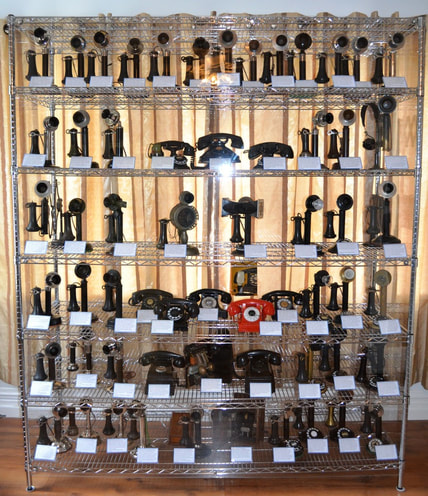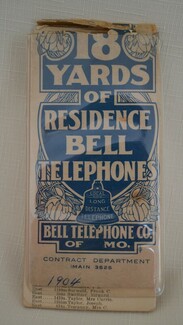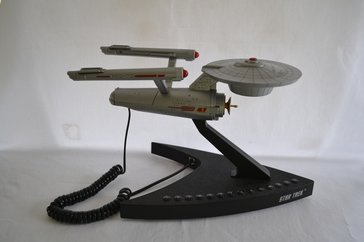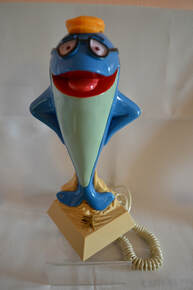|
The Jefferson Barracks Telephone Museum has many hands-on, educational and fun exhibits to enhance your learning experience. Each artifact has a detailed description card which includes its name, the date(s) the item was used and what purpose it served in the telecommunications industry.
Our exhibits are updated on a regular basis so each time you visit we're sure to have some new and interesting artifacts to see! Many of our docents have 30+ years in the telecommunications industry and we love to share our knowledge with our visitors. |
|
Here is a sampling of what you'll see at the museum. |
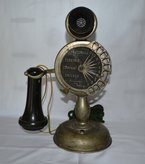
AUTOMATIC ELECTRIC DIAL CANDLESTICK TELEPHONE
This is the first automatic dial telephone, invented around 1905. With its 11-digit dial,
customers could call directly without going through an operator. Almon Strowger,
the inventory, was an undertaker in Kansas City during the late 1800s. The wife of his
only competitor worked the switchboard at the local telephone exchange and when a
caller asked for Strowger, she would put the call through to her husband. After
numerous complaints, Strowger developed the first automatic telephone switch out of
electromagnets and hat pins. On November 3, 1892, the first Strowger exchange was
opened for public service with about seventy-five subscribers. When his system made its debut, Strowger bragged that his exchanges were "girl-less", "cuss-less", "out-of-order-less" and "wait-less". This particular telephone was made by the Automatic Electric Company.
This is the first automatic dial telephone, invented around 1905. With its 11-digit dial,
customers could call directly without going through an operator. Almon Strowger,
the inventory, was an undertaker in Kansas City during the late 1800s. The wife of his
only competitor worked the switchboard at the local telephone exchange and when a
caller asked for Strowger, she would put the call through to her husband. After
numerous complaints, Strowger developed the first automatic telephone switch out of
electromagnets and hat pins. On November 3, 1892, the first Strowger exchange was
opened for public service with about seventy-five subscribers. When his system made its debut, Strowger bragged that his exchanges were "girl-less", "cuss-less", "out-of-order-less" and "wait-less". This particular telephone was made by the Automatic Electric Company.

CHICAGO TANDEM GLASS FRONT TELEPHONE
Circa 1906, this two box telephone was manufactured by the Chicago Telephone Supply
Co. in Elkhart, Indiana. The top portion contains the bells, magneto and necessary
wiring to make it work while the bottom houses two shelves that held the batteries.
This six-bar telephone, known as a bridging telephone, features the Chicago genuine solid back long distance transmitter. It was guaranteed to ring more bells than any telephone from other factories, transmit speech better and farther than any others and outlast any other telephone. These statements were backed by the factory guarantee, which was "as good as a government bond.”
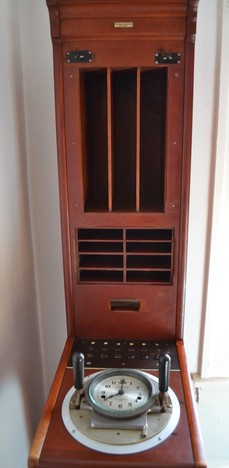
CALCULAGRAPH
Circa early 1900s, the Calculagraph is a device which mechanically
calculates and prints the elapsed time between two events. Originally used
as a means of tracking table usage in pool halls, they later became the
standard way to clock the duration of long distance telephone calls.
While the call was in progress, the toll ticket was stored temporarily in a
slot in the key shelf associated with the cord pair on which the call was
being completed. That way, the operator knew quickly which toll ticket to
slip into the Calculagraph and pull the handle when the call was
completed. Accuracy depended on the operator being very prompt in
stamping the ticket when the conversation began and when it terminated.
It was only as accurate as the operator was fast.
The unit consists of a clock and a precision gear-based set of three printing
wheels, which print on standardized accounting tickets. One of the wheels
presents a clock face and indicates the time at which the call began. It is
printed by pushing forward on the right handle. Pulling back on that same
handle prints a pair of hollow dial faces with quantities printed around the
outside. The ticket is then removed and set aside until the call is completed
at which time the ticket is re-inserted into the Calculagraph and the left handle is pulled back. This prints a pair of arrow indicators in the center of each previously printed dial, pointing at the elapsed time since the call began. The center of each arrow contains a legend.
Circa early 1900s, the Calculagraph is a device which mechanically
calculates and prints the elapsed time between two events. Originally used
as a means of tracking table usage in pool halls, they later became the
standard way to clock the duration of long distance telephone calls.
While the call was in progress, the toll ticket was stored temporarily in a
slot in the key shelf associated with the cord pair on which the call was
being completed. That way, the operator knew quickly which toll ticket to
slip into the Calculagraph and pull the handle when the call was
completed. Accuracy depended on the operator being very prompt in
stamping the ticket when the conversation began and when it terminated.
It was only as accurate as the operator was fast.
The unit consists of a clock and a precision gear-based set of three printing
wheels, which print on standardized accounting tickets. One of the wheels
presents a clock face and indicates the time at which the call began. It is
printed by pushing forward on the right handle. Pulling back on that same
handle prints a pair of hollow dial faces with quantities printed around the
outside. The ticket is then removed and set aside until the call is completed
at which time the ticket is re-inserted into the Calculagraph and the left handle is pulled back. This prints a pair of arrow indicators in the center of each previously printed dial, pointing at the elapsed time since the call began. The center of each arrow contains a legend.
|
1904 WORLD'S FAIR TELEPHONE CHART
Distributed at the 1904 St. Louis World's Fair by The Bell Telephone Company of Missouri, this chart lists the current residence rate of $3.00 per month for a Direct Line and $2.00 per month for a Duplex (two party) Line. In today's dollars, the cost for a monthly Direct Line would be about $85.69 and the Duplex Line would be about $57.12. Unfolded, this chart measures 18 yards, or 54 feet long and lists the exchange, number and first and last names of residential subscribers in alphabetical order. The estimated growth for 1905 was about 10 yards more! |
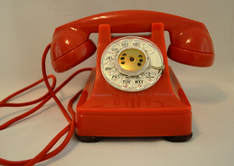
WESTERN ELECTRIC MODEL 302
The Western Electric Model 302 was the first desktop telephone to include the ringer and network wiring. The majority of the Model 302 telephones were black and had dials with metal finger wheels. Colors became available starting in 1939 for those who were willing to pay extra for the color.
Housings were originally made of zinc alloy, but gradually changed around 1941 to thermoplastic sets which were available in ivory, Pekin red, green, blue and rose and had plastic finger wheels. Production was suspended due to WWII but resumed in 1945 with black plastic housings and by 1949 color sets were again being offered.
The Western Electric Model 302 was the first desktop telephone to include the ringer and network wiring. The majority of the Model 302 telephones were black and had dials with metal finger wheels. Colors became available starting in 1939 for those who were willing to pay extra for the color.
Housings were originally made of zinc alloy, but gradually changed around 1941 to thermoplastic sets which were available in ivory, Pekin red, green, blue and rose and had plastic finger wheels. Production was suspended due to WWII but resumed in 1945 with black plastic housings and by 1949 color sets were again being offered.

BELL SYSTEM CABLE CAR
In the construction and maintenance of aerial cable, it was necessary to work along
the supporting strand so a small trolley-like vehicle called a "cable car" was
used. It consisted of a light, steel frame mounted on two rubber-tired wheels and
supported a wooden seat by means of short chains and snap hooks. The height of
the seat could be adjusted by the technician by shortening or lengthening the
chains. To prevent falling, a strap was threaded through the D-ring in the
workman's belt and attached to the eyelets below the wheels.
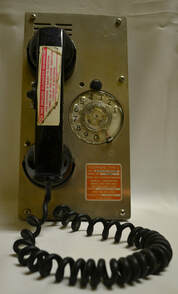
U.S. NAVY ROTARY DIAL TYPE G TELEPHONE
This Type G rotary dial telephone was made for the Navy by Dynalec Corp. and is one of the few companies that still supply sound-powered telephones to the Navy and private ship owners today.
Type G telephones were used in new dial telephone system installations to replace worn-out type A (desk phones), C (splash-proof), and F (bulkhead) phones.
The box, made of heavy gauge steel, features a stainless steel face plate and a baked-on orange enamel plaque identifying the telephone manufacturer and the ordering authority -- the Naval Sea Systems Command.
A sticker on the handset warns, “DO NOT DISCUSS CLASSIFIED INFORMATION. THIS TELEPHONE IS SUBJECT TO MONITORING AT ALL TIMES. USE OF THIS TELEPHONE CONSTITUTES CONSENT TO MONITORING.” The handset “snaps” in place using a pin which secures the handset to the box when not in use.
